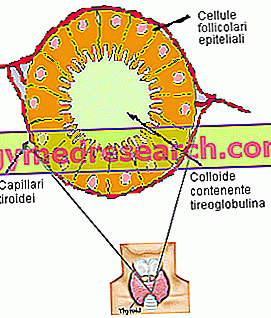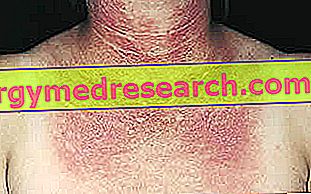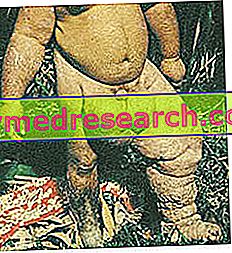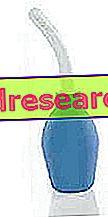Generality
Thyroglobulin (Tg) is the main constituent of the colloid, contained within the thyroid follicles. More specifically, it is an iodine glycoprotein (containing iodine) produced by thyroid cells (thyrocytes).

If necessary, the thyroglobulin is reabsorbed by the colloid, then it is split to give rise to triiodothyronine (T3) and thyroxine (T4).
The production of these thyroid hormones and their release into the bloodstream are stimulated by the pituitary hormone TSH (thyroid stimulating hormone).
The determination of thyroglobulin in the blood is basically used as a tumor marker, to evaluate the efficacy of thyroid cancer therapy and to monitor recurrences .
What's this
Thyroglobulin (Tg) is the precursor glycoprotein molecule of thyroid hormones T3 and T4.
The thyroid gland is organized into very small and tightly packed follicles, so that in adulthood there are about 3 million. Outside these circular structures we find a cuboidal, single-layer follicular epithelium, while in the inner portion there is a gelatinous and yellowish liquid, the colloid, consisting mainly of thyroglobulin.
Thyroglobulin is synthesized by epithelial cells (thyrocytes) of the follicle, in turn surrounded by a dense capillary network, which makes the thyroid one of the most vascularized structures of the body. Just through the bloodstream, the iodine reaches the follicle; at this level it is in fact essential for the synthesis of thyroid hormones, which starts from the ionidation of thyroglobulin by the iodinase enzyme (also called TPO or Iodide peroxidase).
Within the thyroglobulin molecule (which contains 70 tyrosines), thanks to the intervention of the iodine, tyrosine residues can thus be formed with one or two iodine atoms, respectively named MIT or 3-monoiodothyrosine and DIT or 3.5- diiodotyrosine.

Once produced, T3 and T4 are not free, but remain an integral part of the more complex thyroglobulin peptide.
The TSH or thyrotropic hormone, of pituitary origin, represents the main control factor, both for the synthesis of thyroglobulin and for the release in circulation of thyroid hormones. The latter process takes place through a complex cellular mechanism; in fact, the epithelial thyrocytes engulf the thyroglobulin, which under the vesicles (phagosomes) undergoes the degradative action of lysosomal enzymes: the link between thyroglobulin and thyroid hormones is split and the same glycoprotein is degraded. Thus, on the one hand the thyroid hormones are released into the bloodstream, while on the other hand, what remains of the thyroglobulin is recycled inside the same cell, then used for the synthesis of new proteins and thyroid hormones.
Why do you measure
Thyroglobulin determination is useful for monitoring thyroid cancer treatment . Often, this examination is prescribed at regular intervals after the operation, to identify a relapse or the spread of the neoplastic process.
Thyroglobulin is not synthesized by all thyroid tumors, but in the most common forms (such as papillary and follicular adenocarcinomas) an increase in its blood concentrations is frequently observed.

In the presence of some thyroid disorders, thyroglobulin analysis may be required along with other gland tests.
When is the exam prescribed?
- Usually, the examination of thyroglobulin is indicated by the doctor before starting the treatment of thyroid cancer (to define if the tumor is producing it) and then to monitor the changes over time (serial withdrawals).
Thyroglobulin examination may be required prior to surgical removal of the tumor; after surgery, however, it can be prescribed to ensure complete removal of cancerous and / or normal thyroid tissue. Evaluation of the parameter is also useful before and after radioactive iodine therapy.
- Thyroglobulin examination may also be required in assessing the causes of hyperthyroidism and in determining the causes of congenital hypothyroidism in children .
To remember
Increased thyroglobulin concentrations are not diagnostic of thyroid cancer. The diagnosis is made on the basis of histological examination (thyroid biopsy).
The thyroglobulin test may be associated with the dosing of anti-thyroglobulin antibodies (AbTg). These autoantibodies are directed against Tg and can be produced by the immune system at any time.
If present, AbTg can bind circulating thyroglobulin molecules and interfere with the interpretation of the test (underestimation of thyroglobulin values may occur).
Normal values
Thyroglobulin is present in very small amounts in the serum of normal subjects.
In newborns, the level may be higher up to 48 hours after birth.
Its concentration increases in thyroid carcinoma, but also in benign conditions such as hyperthyroidism and endemic goiter.
High Thyroglobulin - Causes
If thyroglobulin concentrations are high at the diagnosis of thyroid cancer, then Tg can be used as a tumor marker.
Thyroglobulin concentrations should be very low or undetectable following thyroidectomy and / or after treatment with radioactive iodine. If the levels are still detectable, normal or cancerous thyroid tissue may still be present; this could lead to the need for further treatment.
The persistence of low thyroglobulin levels for a few weeks or months after thyroidectomy, followed by their subsequent increase, indicates a probable tumor recurrence.
In the presence of goiter, thyroiditis or hyperthyroidism, thyroglobulin levels, even if not routinely requested, may be elevated.
Low Thyroglobulin - Causes
Low concentrations of thyroglobulin are normally present in patients with normal-functioning thyroid.
How to measure it
The concentration of thyroglobulin in the blood is measured on a blood sample, obtained by drawing from a vein in the forearm.
Preparation
Blood sampling is normally performed in the morning, after a fast of at least 8-12 hours.
Interpretation of Results
Thyroglobulin, by virtue of its large size (660 kD molecular weight), cannot cross the follicle wall; consequently, its blood concentrations become important only in the presence of certain thyroid diseases, such as thyroiditis (inflammation of the thyroid) or thyroid carcinoma .
However, there are also several benign conditions accompanied by an increase in thyroglobulin levels in the blood; it is therefore very difficult to discriminate between malignant and benign pathologies.
Consequently, an isolated increase in thyroglobulin values cannot be considered a specific marker for the diagnosis of thyroid cancer; its levels rise, for example, after biopsy of the gland, which is the specific test to diagnose thyroid carcinoma (see article on needle aspiration).
Thyroglobulin levels also rise in the presence of thyroid hypertrophy, nodules, hyperthyroidism, Graves-Basedow disease, toxic and non-toxic goiter, and the aforementioned thyroiditis.
| NORMALITY lower limit | NORMALITY upper limit | Unit of measure | |
| Thyroglobulin (Tg) | |||
| 1.5 | 30 | pmol / L | |
| 1 | 20 | mg / L | |
| NOTE: the reference values may vary from laboratory to laboratory | |||
In patients with Hashimoto's thyroiditis or Graves' disease, it is common to find anti-thyroglobilin antibodies (AbTg), which - although they may be elevated even in apparently healthy euthyroid individuals - can therefore help in the diagnosis of these diseases.
AbTg are antibodies synthesized by the body against thyroglobulin; their concentration in the blood is generally measured together with that of the thyroglobulin itself, since the antibody-Tg bond tends to distort the results of the test, showing lower or higher concentrations depending on the method used.
The dosage of thyroglobulin in the blood, before and after stimulation with TSH, is also used to verify the presence of residual thyroid tissue in thyroidectomized patients (ie who have undergone thyroid removal for therapeutic purposes). In the case of residual thyroid tissue, an increase in Tg can be observed between the sample taken first and that performed after stimulation with TSH. In this case a new iodine removal or ablation procedure is therefore necessary 131.
It must be said, however, that not all thyroid tumors secrete thyroglobulin; nevertheless, this capacity is typical of the two most common types, which are follicular and papillary carcinoma.
In general, therefore, thyroglobulin dosage can be used to support scintigraphic analysis and other techniques in the study of pathogenesis, in the formulation of the diagnosis and in the analysis of the course of thyroid disorders.



